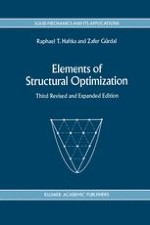1992 | OriginalPaper | Buchkapitel
Dual and Optimality Criteria Methods
verfasst von : Raphael T. Haftka, Zafer Gürdal
Erschienen in: Elements of Structural Optimization
Verlag: Springer Netherlands
Enthalten in: Professional Book Archive
Aktivieren Sie unsere intelligente Suche, um passende Fachinhalte oder Patente zu finden.
Wählen Sie Textabschnitte aus um mit Künstlicher Intelligenz passenden Patente zu finden. powered by
Markieren Sie Textabschnitte, um KI-gestützt weitere passende Inhalte zu finden. powered by
In most of the analytically solved examples in Chapter 2, the key to the solution is the use of an algebraic or a differential equation which forms the optimality condition. For an unconstrained algebraic problem the simple optimality condition is the requirement that the first derivatives of the objective function vanish. When the objective function is a functional the optimality conditions are the Euler-Lagrange equations (e.g., Eq. (2.2.13)). On the other hand, the numerical solution methods discussed in chapters 4 and 5 (known as direct search methods) do not use the optimality conditions to arrive at the optimum design. The reader may have wondered why we do not have numerical methods that mimic the solution process for the problems described in Chapter 2. In fact, such numerical methods do exist, and they are known as optimality criteria methods. One reason that the treatment of these methods is delayed until this chapter is their limited acceptance in the optimization community. While the direct search methods discussed in Chapters 4 and 5 are widely used in many fields of engineering, science and management science, optimality criteria method have been used mostly for structural optimization, and even in this field there are many practitioners that dispute their usefulness.
